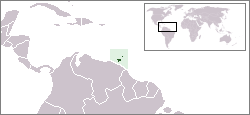This is an old revision of this page, as edited by Jeronimo (talk | contribs) at 14:28, 17 November 2003 (applying country template). The present address (URL) is a permanent link to this revision, which may differ significantly from the current revision.
Revision as of 14:28, 17 November 2003 by Jeronimo (talk | contribs) (applying country template)(diff) ← Previous revision | Latest revision (diff) | Newer revision → (diff)
The Republic of Trinidad and Tobago is an island nation in the southern Caribbean Sea, off the coast of Venezuela. Most important island is Trinidad, while the island of Tobago is much smaller and less populous.
| |||
| National motto: Together we aspire, together we achieve | |||
 | |||
| Official language | English | ||
| Capital | Port of Spain | ||
| President | George Maxwell Richard | ||
| Prime minister | Patrick Manning | ||
| Area - Total - % water | Ranked 163st 5,128 km² Negligible | ||
| Population
- Density | Ranked 151th
215/km² | ||
| Independence | November 30, 1962 | ||
| Currency | Dollar | ||
| Time zone | UTC - 4 | ||
| National anthem | Forged From The Love of Liberty | ||
| Internet TLD | .TT | ||
| Calling Code | 1-868 | ||
History
Main article: History of Trinidad and Tobago
Little is known of the history of the islands before they were discovered by Columbus on July 31, 1498. He named Trinidad after the Holy Trinity; Tobago was named Bella Forma by him, but this later became Tobago (probably derived from tobacco).
The Spanish settled on Trinidad, while Tobago frequently changed hands between the European sea powers, but the settlements on both islands were small and underdeveloped. In the 18th century, Britain acquired both islands, and they were combined into the colony of Trinidad and Tobago in 1889.
Following World War II, when American naval bases were located on Trinidad, the islands became independent as part of the West Indies Federation in 1958. The federation was dissolved quickly, and the independent nation of Trinidad and Tobago was formed in 1962.
At present, the country is one of the most prosperous in the Caribbean, thanks largely to petroleum and natural gas production and processing. Tourism, mostly in Tobago, is targeted for expansion and is growing.
Politics
Main article: Politics of Trinidad and Tobago
Chief of state in Trinidad and Tobago is the president, who is elected by the parliament. This parliament consists of two chamers, the Senate (31 seats) and the House of Representatives (36 seats). The members of the former are appointed by the president, while the members of the latter are chose by the public in elections held every five years.
The prime minister, who heads the House of Representatives, is chose by the president; usually the leader of the largest party is chosen.
Counties and Municipalities
Main article: Counties and Municipalities of Trinidad and Tobago
While Tobago has the status of ward, and is not subdivided, the Trinidad is separated into eight counties and three municipalities. The counties are:
The three towns with municipality-status are:
Geography
Main article: Geography of Trinidad and Tobago
File:Td-map.jpgThe terrain of the islands is mostly plains, although the highest point in the country, El Cerro del Aripo is situated at 940 m above sea level. The climate is tropical with a rainy season in the second half of the year. Unlike many other Caribbean islands, Trinidad and Tobago rarely suffer from tropical storms.
As the majority of the population lives on Trinidad, this is the location of most major towns, including the capital Port of Spain. The largest settlement on Tobago is Scarborough.
Economy
Main article: Economy of Trinidad and Tobago
Trinidad and Tobago has earned a reputation as an excellent investment site for international businesses. A leading performer the past four years has been the booming natural gas sector. Tourism is a growing sector, although not proportionately as important as in many other Caribbean islands. The economy benefits from low inflation and a trade surplus. The year 2002 was marked by solid growth in the oil sector, offset in part by domestic political uncertainty.
Demographics
Main article: Demographics of Trinidad and Tobago
The two most important ethnic groups are the descendants of African slaves, and the so-called East-Indians, (descendants of) immigrants from India. Both groups form about 40% of the population; most of the remainder are people of mixed descent.
Many different religions are present in Trinidad and Tobago. The largest two are the Roman-Catholic Church and Hinduism; the Anglican Church and Islam have smaller groups of followers.
English is the country's only official language, but Hindi is also commonly spoken by the East Indians.
Culture
Main article: Culture of Trinidad and Tobago
Trinidad and Tobago are famous as the birthplace of the calypso music.
| Date | English Name | Remarks |
|---|---|---|
| January 1 | New Year's Day | |
| Variable | Carnival | |
| Variable | Eid-ul-Fitr | |
| Variable | Easter | |
| March 30 | Spiritual Baptism Liberation Shouter Day | |
| Variable | Corpus Christi | |
| May 30 | Indian Arrival Day | |
| June 19 | Labour Day | |
| August 1 | Emancipation Day | |
| August 31 | Independence Day | |
| September 24 | Republic Day | |
| Variable | Diwali | |
| December 25 | Christmas | |
| December 26 | Boxing Day |
Miscellaneous topics
- Communications in Trinidad and Tobago
- Military of Trinidad and Tobago
- Foreign relations of Trinidad and Tobago
- Music of Trinidad and Tobago